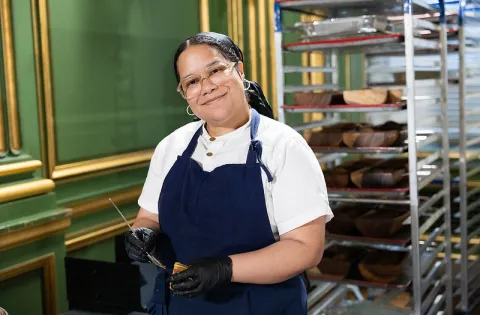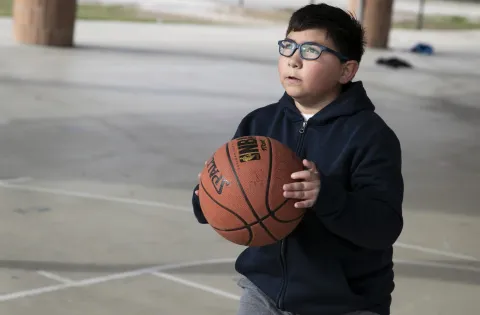Teaching kids and teens about hunger can help inspire compassion, empathy, understanding, and a desire to make a difference. Millions of children live in homes where food is not consistently available. Although it’s a complex and challenging issue, which includes barriers to food access due to systemic and racial injustices, children can begin learning about childhood hunger at a very young age.
We have the incredible opportunity to inspire change through educating our kids and having open conversations. This includes talking about the importance of making sure people have access to healthy food and how stigmatization causes hunger. Here are a few things parents and guardians can keep in mind to help kids and teens learn about hunger and what they can do to help.
Take a developmentally appropriate approach.
As you think about how to talk to your child(ren) about this issue, their age and maturity level will play an important part in determining the best approach. How you speak to a five-year-old will naturally differ from how you would converse with your older teen.
Use the following guidelines to adapt your approach for your child(ren):
Ages 4 to 6
- Address feelings (both theirs and yours): You might say, “It’s okay to feel sad or worried. These things make me feel that way too.” Assure them that their feelings are natural and that there are ways to turn those feelings into motivation to make a difference.
- Use vocabulary and concepts they are familiar with. It can be helpful to find a way to relate the topic to a situation in their lives in order to provide a certain level of context. For example, you can remind them that sometimes they may feel tired or cranky, but they feel better once they’ve had something to eat. Connecting your story to a tangible situation your child has experienced will help make a lasting impact.
Ages 7 to 12
- Find out what they know and think about childhood hunger. Children may have heard about the issue or explored it in school at this age. Try to get a feel for what they know so far, so you can either expand on that or address possible gaps in their understanding.
- Tackle the issue of the stigma that kids and families dealing with hunger may face. One of the most serious aspects of hunger is the stigma that comes with it, but it doesn’t have to be that way. Many kids who experience hunger may feel embarrassed about receiving free or reduced meals in school. Breaking the cycle by teaching kids how to be compassionate toward others in a difficult situation instead of passing judgment is incredibly important. By talking to kids about it, as well as dispelling misconceptions they might hear from their peers, we can begin doing the hard work of eliminating the stigma.
Ages 13 and up
- Encourage them to consider the complexities of the subject. Teens are often remarkably passionate about solving the social injustices in our world, and we can help them harness that determination by honing their ability to take problem-solving perspectives. Ask them what they think about the challenges involved in ending childhood hunger and how they can navigate them.
- Admit that you don’t have all the answers. Particularly at this age, young people can process that the adults in their lives don’t know everything. Be honest if you find yourself unable to provide a suitable answer to their questions, and then suggest finding a solution together.
Lead thoughtful, open-ended discussions about hunger issues.
One of the most powerful ways we can impact our children is also the most simple: having honest conversations, even about the tough stuff. This includes talking to kids about children living with hunger - not just once but on an ongoing basis as they grow older.
Children are likely to have numerous questions about this difficult topic and their questions can often be very challenging to answer. It’s normal to feel unsure during these conversations, but you can model important skills by being (appropriately) transparent with children in these moments. For example, you might say, “This is really tough to talk about, and I don’t have all the answers. But it also can help us feel more hopeful about finding ways to make a change.”
Below, we’ve provided a series of questions that can help you start a conversation, so you can help children think more deeply about the issue and how they can be a part of the solution. Consider the age of your child(ren) to choose appropriate questions, and be sure to take an active, guiding role throughout the conversation.
- What does it feel like to be hungry?
- When you feel hungry, how does it affect your mood, concentration, etc.?
- What is the difference between being hungry for lunch and being hungry all the time because you don’t have enough to eat on a regular basis?
- What might happen to someone physically, emotionally and mentally if they are hungry for a long time?
- How might hunger affect different areas of life, such as school or work?
- What would it feel like not knowing where your next meal will come from?
- What things do you think cause people to experience hunger?
- Are certain groups of people more likely to experience hunger?
- How can kids your age help make a difference?
- Are there actions you can take to have an impact now?
Show them how they can make a difference.
As you expand your child(ren)’s understanding of the issue of hunger, consider ways to empower them to take real action. Young people are often highly motivated to get involved, and we can help by giving them the ideas, tools, and confidence they need to truly make a change.
Here are just a few ways that children and teens can put what they’ve learned about hunger to use.
- Start a campaign to write letters to local lawmakers or school officials, advocating for programs that address hunger in your community. Letter templates from Share Our Strength can help your child(ren) get started.
- Plan a fundraiser to contribute to the cause, such as a fun run, charity auction, or many other events. Young children can participate by decorating signs or helping make baked goods, while older children and teens can take a bigger role in leading the project.
- Share real-life stories about kids who have taken action to end childhood hunger and the unique ways that young people are working together to make a difference.
- Invite kids to sign up to be youth advocates for No Kid Hungry if they are interested in discovering more about what they can do to help spread awareness about hunger.
Join the Fight Against Childhood Hunger
Whether you are a parent, teacher, community advocate, or young person, there are many ways to get involved in the fight against hunger and positively impact your community. Every effort counts, from making a donation to organizing a fundraiser to contacting your elected officials.
No Kid Hungry is a national campaign run by Share Our Strength, a nonprofit working to solve problems of childhood hunger and poverty in the U.S. and around the world. We are committed to helping people discover their power to make a difference. Children and adults can play an essential part in finding a solution to hunger, and No Kid Hungry can help.
Learn about more ways to support No Kid Hungry. Your help can greatly impact the lives of children and entire families facing hunger.
Image Credits: fizkes - Dragana Gordic / Shutterstock



